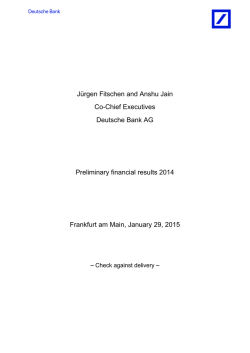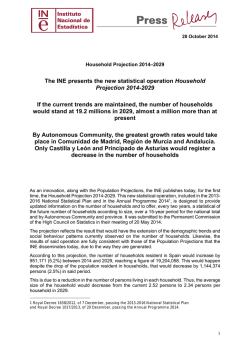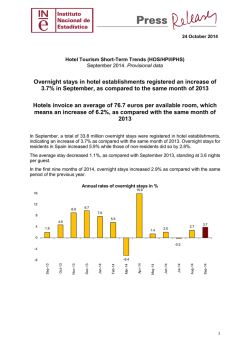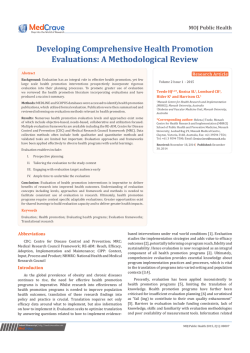
DAILY INSPECTION SCHEDULE 3/27/15 INSPECTIONS MUST BE
16 October 2014 Quarterly Spanish National Accounts. Base 2010 Quarterly Non-financial Accounts for the Institutional Sectors Second quarter of 2014 In the second quarter of 2014, the net borrowing of the national economy, as compared with the rest of the world, is estimated at 1,362 million euros In the second quarter of 2014, the savings rate for households and non-profit institutions serving households stands at 15.0% of their disposable income This release of the Quarterly Non-financial Accounts for the Institutional Sectors (QNFAIS) from the second quarter of 2014 is the first one that has been carried out with the new Spanish National Accounts 2010 Base, whose release of main annual results was disseminated the past 25th of September. These constitute the first QNFAIS estimates that have been drafted in accordance with the new EU compulsory methodological standard: European System for National and Regional Accounts (ESA-2010), passed by the Regulation (EU) No 549/2013 of the European Parliament and the Council of 21st May 2013. This last 12th June, the INE released a methodological note on the implementation of the ESA2010 in the Spanish National Accounts in accordance with the indicator 6.6 of the European Statistics Code of Practice on the advance announcement revisions and important changes in the methodology. Said note explained that the last QNFAIS release with the 2008 Base would be the one for the first quarter of 2014 and that, starting on 25th September, all Spanish National Accounts releases would refer to the new 2010 Base. Likewise, the press release from 2nd July –constituting the last QNFAIS one released in base 2008– announced the release of the complete series of results for base 2010 on 16th October, that is, from first quarter 1999 to second quarter 2014. It is also worth noting that the transaction “Quarterly Non-financial Accounts for the Institutional Sectors. Base 2010”1 has been included in the National Statistical Plan 2013-2016 and the 2013 and 2014 Annual Programmes. The changes made in the National Accounts entail the implementation of diverse methodological and statistical changes in the development of results. As for the institutional 1 Royal Decree 1658/2012 of 7th December, which approves the National Statistical Plan 2013-2016; Royal Decree 90/2013 of 8th February, which approves the 2013 Statistical Annual Programme of the National Statistical Plan 2013-2016; and Royal Decree 1017/2013 of 13th December, which approved the 2014 Statistical Annual Programme of the National Statistical Plan 2013-2016. 1 sectors that constitute the national economy2, attention should be drawn to those affecting delimitation and division of the Public Administration and Financial Institutions or affecting as well the basic sources of information for account drafting, such as the implementation of the estimates for the new Balance of Payment system, as detailed in the annex to this note. National Economy The national economy presented a net borrowing of 1,362 million euros, as compared with the rest of the world, during the second quarter of 2014, representing 0.5% of GDP for said period. This figure is lower by 7,315 million euros than that estimated for the same quarter of the previous year (8,677 millions, that is, 3.2% of the GDP). This greater financing need (net borrowing) of the Spanish economy was mainly due to a weaker performance of both the balance of exchanges of goods and services and the balance of income and current transfers and of capital with the rest of the world. Imports of goods and services increased by 3,716 million euros, whereas exports of the same sectors decreased by 741 millions. Therefore, the balance of exchanges of goods and services with the rest of the world decreased by 4,457 million as compared to the second quarter of 2013 (7,306 as compared to 11,763 millions). The balance of income and current transfers also registered a decrease of 2,191 millions (–7,697 millions this quarter, as compared to –5,506 in the same period of 2013). Finally, the balance of capital transfers decreased by 1,029 million as compared to the second quarter of 2013. Net lending (+) / Net borrowing (-) Total Economy 8,677 8,000 4,000 1,362 -759 0 -3,419 Million euros -4,689 -4,000 -5,215 -4,843 -5,135 -5,410 -7,798 -9,702 -8,000 -12,000 -10,180 -14,752 -16,000 -18,811 -20,000 -22,420 -25,877 -24,000 -28,000 -32,000 1999 2000 2001 2002 2003 2004 2005 2006 2007 2008 2009 2010 2011 2012 2013 2014 2 Non-financial Corporations, Financial Institutions, Public Administrations, Households and Non-profit Institutions Serving Households. 2 The following table shows the breakdown by institutional sector of the net borrowing of the national economy in the second quarter of 2014, in comparison with the same period of 2013. Net Lending (+) / Net Borrowing (-). Second quarter 2014. Institutional Sector Households and NPISH General Government Financial Corporations Non-Financial Corporations Total 2013 2014 Difference 25,058 -32,097 8,492 7,224 18,251 -30,537 7,328 6,320 -6,807 1,560 -1,164 -904 8,677 1,362 -7,315 Households and Non-profit Institutions Serving Households Sector During the second quarter 2014, gross disposable income for the Households and Non-profit Institutions Serving Households (NPISH) sector reached 184,972 million euros, 0.8% less than in the second quarter of 2013. This drop was mainly due to the 0.8% decrease of the balance of gross primary income of the sector. In that sense, the gross operating surplus and the gross mixed income registered a 2.0% decrease; on top of this, the net balance of property income received by households and NPISH (interests, dividends, etc.) was 28.6% lower than that of the same period of 2013; the performance of these two components offset the 1.8% increase recorded by the employees’ remuneration. Secondly, the decrease in the gross disposable income was due to the increase of the amount paid in form of social benefits (1.1%), and taxes on income and property (0.2%). Said increases were higher, in absolute terms, than those registered in the net volume of benefits received by households (0.1%) and in the net balance of other current transfers perceived (42.2%) Regarding the use of disposable income, final consumption expenditure of households and NPISH was estimated at 156,958 million euros in the second quarter, that is, 3.3% more than the same period of 2013. Therefore, households (along with NPISH) had 27,787 million euros more than they spent, although this amount was fewer than that of the second quarter 2013. In other words, gross savings stood at 27,787 million euros, as compared with 34,179 during the same period of 2013. Thus, the savings rate of household and NPISH dropped to 15%, as compared to the 18.3% registered in the same quarter of the previous year. 3 Savings rate of Households and NPISH Percentage of Disposable Income 24 21.5 19.8 18.4 18.3 19 16.2 16.1 14.4 14 15.0 14.7 14.1 12.9 12.2 12.1 12.8 12.8 11.3 9 4 -2 1999 2000 2001 2002 2003 2004 2005 2006 2007 2008 2009 2010 2011 2012 2013 2014 On calculating the savings rates for the households and NPISH sector referring to mobile periods of fourth quarters, the savings rate for the sector registered a decrease of one point during the quarter, up to 9.1%. Percentage of Disposable Income Savings rate of Households and NPISH (mobile year) 19 17 14.4 15 12.4 13 11.1 11 9.9 10.7 11.0 10.7 10.3 10.0 9.4 9.1 8.9 9 12.4 8.3 7.6 7 2000 2001 2002 2003 2004 2005 2006 2007 2008 2009 2010 2011 2012 2013 2014 In turn, the net balance of capital transfers received by households and NPISH decreased by 14.9%, reaching 622 millions. Said balance, together with gross savings generated by the sector was enough to finance the amount of investment registered by that one in the period, of 10,158 million euros (3.3% more than in the same quarter of 2013). This way, during the first quarter, the sector generated finance capacity of 18,251, as compared with 25,058 in the second quarter of 2013. 4 Net lending (+) / Net borrowing (-) Households and NPISH 30,000 25,058 22,868 21,474 20,648 18,695 Million euros 20,000 10,000 3,532 2,606 144 18,251 5,279 1,646 1,519 1,386 -1,007 -2,956 0 -3,459 -10,000 -20,000 -30,000 1999 2000 2001 2002 2003 2004 2005 2006 2007 2008 2009 2010 2011 2012 2013 2014 Non-financial Corporations Sector Gross disposable income of non-financial corporations experienced a decrease of 8.5% in the second quarter, with regard to the same period in 2013, reaching 39,947 million euros. This behaviour was firstly explained by the 6.0% decrease in the gross balance of primary income (with a decrease of 1.5% in the gross operating surplus, and a 24.4% drop in the net balance of property income received). In addition, a greater amount paid in terms of company taxes was registered (a 23.7% increase), which compensated for a lower net balance of social contributions and other paid current transfers. Nevertheless, the disposable income of the corporations, together with the positive balance of 2,256 million euros corresponding to net capital transfers received, was enough to finance the investment volume of the sector, which reached 35,883 million (7.7% less than in the same quarter the previous year). As a result, net lending was estimated at 6,320 million euros for the sector, 904 millions less than for the same period the previous year. 5 Net lending (+) / Net borrowing (-) Non-financial corporations 20,000 9,329 10,000 Million euros 0 7,224 5,900 -3,336 -5,857 -4,201 -3,458 6,320 3,749 3,041 -2,708 -7,014 -12,070 -10,000 -9,098 -10,298 -22,416 -20,000 -30,000 -40,000 1999 2000 2001 2002 2003 2004 2005 2006 2007 2008 2009 2010 2011 2012 2013 2014 Public Administration Sector In the second quarter of 2014, Public Administrations decreased their gross disposable income by 0.5% as compared with the same period of 2013, reaching the figure of 29,743 million euros. This result was due to the 0.6% decrease in the balance of primary income, in spite of the greater net income from subsidies for taxes on production and imports (0.4%). Moreover, there was an increase in the balance of current transfers of 25.5% as compared to that registered in the second quarter of 2013, and a decrease of 0.1% in social benefits paid. Both balances compensated for more resources proceeding from taxes on income and property (0.8%) and the amount paid in form of social benefits (decreasing by 0.8%) Income generated by the Public Administrations during the first quarter of the year was not enough to finance their final consumption expenditure, which increased by 1.1%, reaching 54,077 million euros. Thus, gross savings for the sector stood at -24,334 million euros, as compared to the negative figure of -23,468 in the same quarter of 2013. This result, together with a net balance of capital transfers paid of 512 million euros and an investment of Public Administrations of 5,691 millions, determined the net borrowing of the sector, which stood at 30,537 million euros, as compared to 32,097 for the same quarter of 2013. 6 Net lending (+) / Net borrowing (-) General Government 30,000 20,000 10,000 Million euros 0 -10,000 -1,256 -4,532 -4,606 -7,354 -8,498 -7,727 -5,387 -3,090 -4,971 -20,000 -20,973 -30,000 -40,000 -35,560 -33,793 -32,097 -30,537 -36,530 -43,623 -50,000 -60,000 1999 2000 2001 2002 2003 2004 2005 2006 2007 2008 2009 2010 2011 2012 2013 2014 Financial Institutions Sector In the second quarter of 2014, gross disposable income for the financial institutions sector increased up to 9,871. This result was mainly due to the increase registered in the gross operating surplus of the sector (29.5%), the net balance of the property income (65.5%), and the lesser amount paid as social benefits (54% less.) The gross disposable income generated this quarter, together with a negative balance of net capital transfers received (–738 million euros) and an investment of 2,032 million euros, caused the Financial Institutions to obtain net lending of 7,328 million euros this quarter. 7 Net lending (+) / Net borrowing (-) Financial corporations 40,000 35,000 30,000 Million euros 25,000 20,000 13,327 15,000 8,492 8,426 10,000 7,328 5,201 5,000 1,843 2,280 2,206 3,628 3,520 2,437 1,059 792 0 865 1,835 -2,467 -5,000 1999 2000 2001 2002 2003 2004 2005 2006 2007 2008 2009 2010 2011 2012 2013 2014 8 ANNEX. Methodological note on the new 2010 Base for the Non-financial Accounts for the Institutional Sectors This release of the Quarterly Non-financial Accounts for the Institutional Sectors (QNFAIS) from the second quarter of 2014 is the first one that has been carried out with the new Spanish National Accounts 2010 Base, whose release of main annual results was disseminated the past 25th September. The methodological changes included in the 2010 base of Spanish National Accounts are those derived from the adaptation of the Spanish National and Regional Accounts to the regulation of the new European System of Accounts (ESA-2010) passed by European Parliament and Council Regulation (EU) 549/2013 of 21st May 2013. This last 12th June, the INE released a methodological note on the implementation of the ESA2010 in the Spanish National Accounts in accordance with the indicator 6.6 of the European Statistics Code of Good Practice on the advanced announcement revisions and important changes in the methodology. Said note explained that the last QNFAIS release with the 2008 Base would be the one for the first quarter of 2014 and that, starting 25th September, all Spanish National Accounts releases would refer to the new 2010 Base. Likewise, the press release from 2nd July –constituting the last QNFAIS one released in base 2008– announced the release of the complete series of results for base 2010 on 16th October, that is, from first quarter 1999 to second quarter 2014. It is also worth noting that the transaction “Quarterly Non-financial Accounts for the Institutional Sectors. Base 2010”3 has been included in the National Statistical Plan 2013-2016 and the 2013 and 2014 Annual Programmes. Base changes in national accounts are characterised by the incorporation of methodological modifications, as well as statistical changes. The first ones are usually due to lateral modifications that affect all countries and, in the case of the European Union, have adopted the form or Regulations since 1999. In turn, the latter mainly depend on the status of the statistical bases of the Member States at each moment and the new aspects that are introduced in each particular country. This way, when the 1995 Regulation of the European System of Accounts (ESA-1995) entered into force in 1999, the Spanish National Accounts and those of the rest of Member States were compiled in accordance with a European Regulation for the first time. This led to the compilation of the Spanish National Accounts, base 1995. After that date and up to now, in order to update the estimates of Spanish National Accounts and make them more relevant and accurate, they have undergone two base changes. One in the year 2005, in which the national accounts moved to base 2000 and another one in the year 2011 with the presentation of the estimates of Spanish National Accounts with base 2008, which remains in force today. The current Spanish National Accounts, base 2008, give way to the new NAS 2010. In this change, like in any other operation of national accounts base change, the two type of modifications that were previously explained take place. On the one hand, there are modifications that come from the implementation of the new ESA 2012 principles 3 th Royal Decree 1658/2012 of 7 December, which approves the National Statistical Plan 2013th 2016; Royal Decree 90/2013 of 8 February, which approves the 2013 Statistical Annual th Program m e of the National Statistical Plan 2013-2016; and Royal Decree 1017/2013 of 13 Decem ber, w hich approved the 2014 Statistical Annual Programm e of the National Statistical Plan 2013-2016. 9 (methodological modifications). On the other hand, the methodological change is used to incorporate updates in the estimation of each item of macroeconomic data, which have their base in the incorporation of new statistical sources, revision of those already existing or in the updating of the estimation methods and procedures of those (statistical modifications). As for methodological changes derived from the application of ESA-2010, there are worth noting those ones that have direct incidence on the delimitation or partitioning in sub-sectors of certain institutional sectors that have been object of special attention in European economic politics over the last years: Public Administrations and Financial Institutions. In this way, it is necessary to note that in the new system there is a more extensive and exhaustive treatment of matters regarding the public sector. In this sense, ESA-2010 expands the guidelines on the delimitation of the institutional sector of Public Administrations4. On the other hand, ESA-2010 establishes a greater breakdown by sub-sectors of the Financial Institutions sector and a bigger amount of detail for financial tools. Availability of greater detail in the information will allow an exhaustive analysis of the sector and will provide more consistency with financial statistical systems of the European Central Bank (ECB) and the International Monetary Fund (IMF). Regarding the Rest of the World account, some guidelines collected in ESA-2010 also affect the register of the operations recorded in it. In particular, those regarding transactions of triangular trade of goods and goods sent abroad to be processed without there being a change of property. In both cases, the register proposed by ESA-2010 is the same as the one compiled in the recommendation of the 6th edition of the Balance of Payments Manual and International Investment Position (BPM6) of the IMF5. Furthermore, among the numerous methodological changes within ESA-2010 regarding ESA1995, the most significant ones in terms of their incidence on Gross Domestic Product (GDP) level are the acknowledgement as an investment (gross fixed capital formation) in the expenditure on research and development (R&D) as well as on armament systems. In ESA-1995, R&D was not acknowledged as gross fixed capital formation despite the fact that the consolidated opinion in the scientific community was that this expenditure should be considered an investment due to its important contribution to the growth of the future economy. Instead of that, R&D expenditure was registered as intermediate consumption, as if its use in the production process had completely finished at the end of the period. In ESA-2010 the expenditure on R&D is treated as an investment on fixed assets and therefore, depreciation of these assets as consumption of fixed capital. This change has a strong effect mainly on Nonfinancial Corporations and Public Administrations accounts, and it will involve an increase of GDP regarding the one calculated according to the methodology of the previous version of the system of accounts. On the other hand, according to ESA-1995, there was only registration of the purchase of military structures and equipment that had an equivalent use for civil purposes (airfields, military hospitals…). In ESA-2010, the definition of fixed assets in the military scope is harmonised with their general definition for the rest of economic sectors. This way, the 4 It is important to point out that the General Controller of the State Administration (GCSA) is the entity responsible for the non-financial accounts of the Public Administration Sector, as appears specifically in the current National Statistical Plan. The GCSA, the Bank of Spain and the INE work together with 5 These methodological changes have been introduced at the same time in the Spanish economy financial accounts, the Balance of Payments (prepared by the Bank of Spain and released yesterday), and in the INE nonfinancial accounts that are presented in this document. 10 definition of fixed assets of a military nature includes weapons and support systems used continuously for more than one year in the production of defence services. The effect of this change causes an increase of GDP as it influences on the fixed capital consumption of the Public Administrations. Besides methodological changes, the 2010 base incorporates, as compared to the 2008 base, statistical changes, as it has been already explained. This modifications have their origin in the use of new statistical sources (or revisions in those existing) as well as in the update and incorporation of estimation methods and procedures of accounting aggregates. Among the changes related to statistical sources for estimations of QNAIS in 2010 base, worth noting is the incorporation of information on the external sector coming directly from the Balance of Payments and International Investment Position prepared by the Bank of Spain according to the methodology of the Sixth Balance of Payments Manual (BPM6) of the IMF. This methodology is coherent with the suggestions of ESA-2010. On the other hand, the integration of information comes from 2011 Population and Dwelling Census, both directly and through surveys that provide base information for national accounting, such as the Economically Active Population Survey (which was updated in April 2014) or the Household Budget Survey. These affect the institutional sectors’ current and accumulation accounts through the changes originated in the estimates of the main macroeconomic aggregates. Likewise, in the new 2010 base there have been revisions of the estimation methods of certain accounting aggregates, as is usual in base changes of National Accounts. The objective of these revisions is to improve the quality of the data estimated in economic accounts. Some examples are the estimation of software production for own final use of the Public Administrations Sector or the performance of a thorough study of the units that will be part of the Non-profit institutions serving households (NPISH). Following is a comparison between the series of results with both accounting bases in terms of the national institutional sectors’ financing capability and necessity: 11 Net Lending (+) / Net Borrowing (-) Total Economy 60,000 50,000 40,000 Million euros 30,000 20,000 10,000 0 -10,000 -20,000 -30,000 -40,000 -50,000 -60,000 2000 2001 2002 2003 2004 2005 2006 2007 Base 2010 2008 2009 2010 2011 2012 2013 2014 2010 2011 2012 2013 2014 Base 2008 Net Lending (+) / Net Borrowing (-) General Government 60000 50000 40000 Million euros 30000 20000 10000 0 -10000 -20000 -30000 -40000 -50000 -60000 2000 2001 2002 2003 2004 2005 2006 Base 2010 2007 2008 2009 Base 2008 12 Net Lending (+) / Net Borrowing (-) Financial Institutions 60000 50000 40000 Million euros 30000 20000 10000 0 -10000 -20000 -30000 -40000 -50000 -60000 2000 2001 2002 2003 2004 2005 2006 2007 Base 2010 2008 2009 2010 2011 2012 2013 2014 2012 2013 2014 Base 2008 Net Lending (+) / Net Borrowing (-) Non-financial Corporations, Households and NPISH 60000 50000 40000 Million euros 30000 20000 10000 0 -10000 -20000 -30000 -40000 -50000 -60000 2000 2001 2002 2003 2004 2005 2006 Base 2010 2007 2008 2009 2010 2011 Base 2008 Finally, it is worth mentioning that the results released today are provisional. They will be revised in the next release of this transaction, for the third quarter of 2014, so as to include the estimates of the complete series of the Spanish Quarterly National Accounting with 2010 Base, which is foreseen to be disseminated 27th November. Together with the release of the information on the QNFAIS series with 2010 Base, some annual results of the Spanish National Accounting will be included, which were yet to be released. 13 Further information The Quarterly non-financial accounts for the Institutional Sectors are shown under two perspectives: integrated economic accounts and detailed accounts of the institutional sectors. This presentation is similar to that used traditionally with the Annual National Accounts of the Institutional Sectors, which are part of the Spanish National Accounts. For more detailed information the INE website (www.ine.es) may be consulted. This website includes updated results for the period from the first quarter of 2000 to the first quarter of 2014. For further information see INEbase-www.ine.es/en/welcome_en.htm www.ine.es/prensa/prensa_en.htm All press releases at: Press office: Telephone numbers: 91 583 93 63 / 94 08 – Fax: 91 583 90 87 - [email protected] Information Area: Telephone number: 91 583 91 00 – Fax: 91 583 91 58 – www.ine.es/infoine 14
© Copyright 2026






